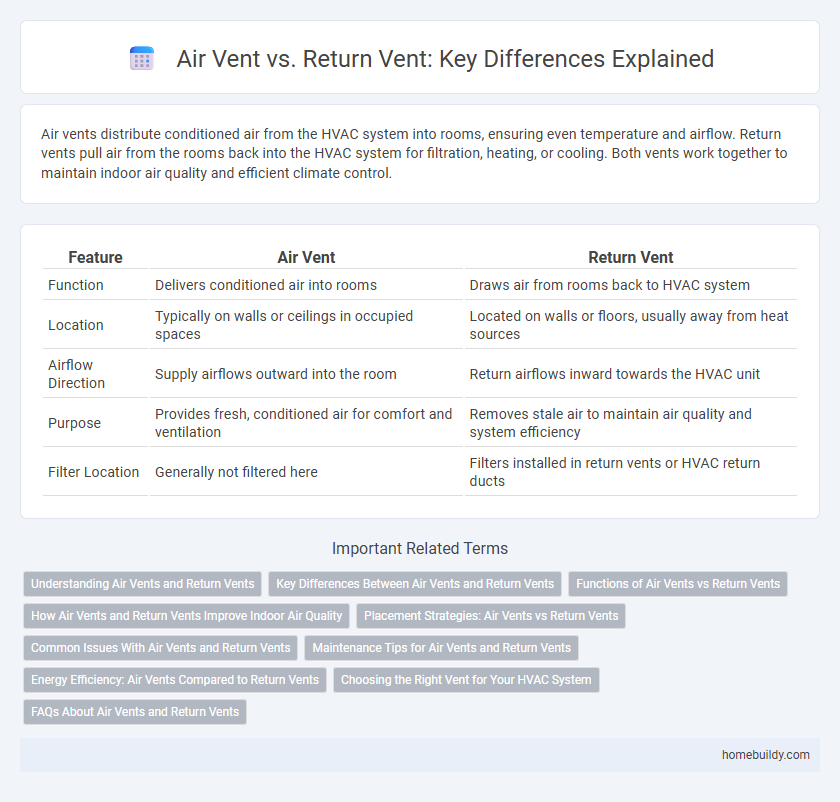Air vents distribute conditioned air from the HVAC system into rooms, ensuring even temperature and airflow. Return vents pull air from the rooms back into the HVAC system for filtration, heating, or cooling. Both vents work together to maintain indoor air quality and efficient climate control.
Table of Comparison
| Feature | Air Vent | Return Vent |
|---|---|---|
| Function | Delivers conditioned air into rooms | Draws air from rooms back to HVAC system |
| Location | Typically on walls or ceilings in occupied spaces | Located on walls or floors, usually away from heat sources |
| Airflow Direction | Supply airflows outward into the room | Return airflows inward towards the HVAC unit |
| Purpose | Provides fresh, conditioned air for comfort and ventilation | Removes stale air to maintain air quality and system efficiency |
| Filter Location | Generally not filtered here | Filters installed in return vents or HVAC return ducts |
Understanding Air Vents and Return Vents
Air vents distribute conditioned air from HVAC systems into living spaces, enhancing airflow and temperature control. Return vents, on the other hand, pull air from rooms back into the HVAC system for filtering and reconditioning, maintaining efficient circulation. Proper placement and balance of air vents and return vents optimize indoor air quality and energy efficiency.
Key Differences Between Air Vents and Return Vents
Air vents, also known as supply vents, deliver conditioned air from the HVAC system into living spaces, while return vents pull air from these spaces back into the system for filtering and reconditioning. Air vents typically contain adjustable louvers to control airflow direction and volume, whereas return vents usually have larger openings or grilles designed to handle higher volumes of air without obstruction. Understanding the key differences between air vents and return vents is essential for optimizing airflow efficiency and maintaining balanced indoor air pressure.
Functions of Air Vents vs Return Vents
Air vents supply fresh, conditioned air into a room to maintain temperature and air quality, while return vents pull stale air back into the HVAC system for filtering and reconditioning. Air vents regulate airflow direction and volume, ensuring comfort and efficient heating or cooling. Return vents contribute to balanced air circulation by removing used air, preventing pressure imbalances and improving system efficiency.
How Air Vents and Return Vents Improve Indoor Air Quality
Air vents distribute fresh, conditioned air into living spaces, ensuring consistent airflow and temperature control, while return vents draw stale air back into the HVAC system for filtration and reconditioning. This continuous circulation reduces indoor pollutants, allergens, and humidity levels, significantly enhancing indoor air quality. Properly balanced air vents and return vents prevent air stagnation and promote a healthier, more comfortable indoor environment.
Placement Strategies: Air Vents vs Return Vents
Air vents are strategically placed in rooms to deliver conditioned air directly, typically located near windows or exterior walls to counteract drafts and ensure efficient airflow distribution. Return vents, on the other hand, are positioned in central or interior areas to draw air back into the HVAC system for reconditioning, maximizing air circulation and system performance. Proper placement of both air vents and return vents optimizes indoor air quality and energy efficiency by maintaining balanced airflow throughout the space.
Common Issues With Air Vents and Return Vents
Air vents frequently suffer from blockages caused by dust accumulation, reducing airflow efficiency and increasing energy costs. Return vents often face issues with improper placement or size, leading to poor circulation and uneven temperature distribution in HVAC systems. Both vent types require regular maintenance to prevent mold growth and ensure optimal indoor air quality.
Maintenance Tips for Air Vents and Return Vents
Regular cleaning of air vents and return vents prevents dust buildup, ensuring better airflow and improved indoor air quality. Inspect filters monthly and replace or clean them as recommended to maintain HVAC system efficiency. Sealing any leaks around vents helps reduce energy loss and improves overall system performance.
Energy Efficiency: Air Vents Compared to Return Vents
Air vents deliver conditioned air directly into rooms, supporting balanced temperature distribution and reducing energy waste by minimizing over-conditioning in specific areas. Return vents play a crucial role by pulling airflow back into the HVAC system, maintaining consistent pressure and system efficiency. Optimizing the placement and functionality of both air vents and return vents enhances overall energy efficiency by ensuring effective airflow circulation and reducing HVAC workload.
Choosing the Right Vent for Your HVAC System
Air vents and return vents serve distinct roles in an HVAC system, with air vents delivering conditioned air into living spaces and return vents drawing air back to the system for reconditioning. Selecting the right vent involves considering airflow capacity, placement, and compatibility with your HVAC specifications to ensure optimal efficiency and air quality. Properly matched vents contribute to balanced air circulation, reduced energy costs, and improved system performance throughout the home.
FAQs About Air Vents and Return Vents
Air vents distribute conditioned air into rooms, while return vents pull air back to the HVAC system for reconditioning. Common FAQs about air vents and return vents include differences in function, placement, and maintenance requirements. Understanding their roles helps optimize airflow and improve indoor air quality.
air vent vs return vent Infographic

 homebuildy.com
homebuildy.com